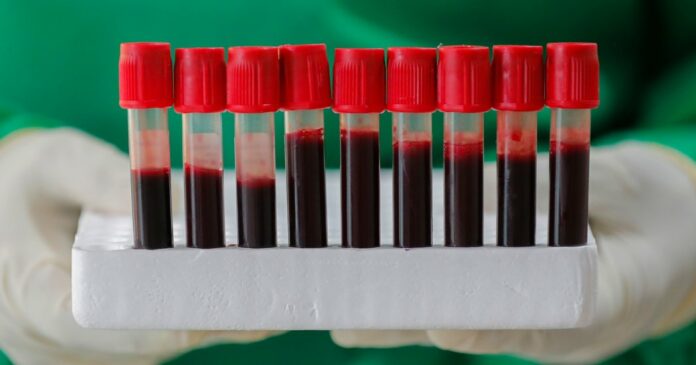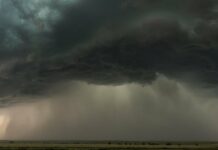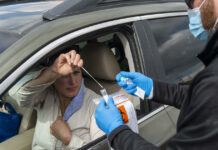matter
New studies show that people with Type A blood are not at greater risk of getting sick, as previous studies had suggested.

Early in the Covid-19 pandemic, researchers found preliminary evidence suggesting that people’s blood type might be an important risk factor — both for being infected by the virus and for falling dangerously ill.
But over the past few months, after looking at thousands of additional patients with Covid-19, scientists are reporting a much weaker link to blood type.
Two studies — one at the Massachusetts General Hospital and the other at Columbia Presbyterian Hospital in New York — did not find that Type A blood increases the odds that people will be infected with Covid-19.
The new reports do find evidence that people with Type O blood may be slightly less likely to be infected. But the effect is so small that people shouldn’t count on it. “No one should think they’re protected,” said Nicholas Tatonetti, a data scientist at Columbia University.
Reviewing medical records for 7,770 people who tested positive for the coronavirus, Dr. Tatonetti and a graduate student, Michael Zietz, found that people with Type A blood were at a somewhat lower risk of being placed on ventilators. People who were Type AB were at a higher risk, but the scientists cautioned that this result might not be reliable because there were so few patients with that blood type in their analysis.
Dr. Tatonetti and Mr. Zietz released the initial results from 1,559 patients at Columbia Presbyterian Hospital in April. Their larger survey is now under review for publication in a scientific journal.
The other new study, carried out at Massachusetts General Hospital, offers a somewhat different picture. The researchers also found that people with Type O were slightly less likely to get Covid-19. But blood type did not affect whether people would have to be placed on ventilators, or their odds of dying.
Anahita Dua, a vascular surgeon at the hospital and the senior author of the study, said that blood type was not something she’d consider when judging the risks faced by patients who tested positive for Covid-19. “I wouldn’t even bring it up,” she said.
“With this new paper, it’s probably decided that blood groups are not influencing the outcome of the disease,” said Joern Bullerdiek, the director of the Institute for Medical Genetics at University Medicine Rostock in Germany.
Even if blood types don’t matter much for treating people with Covid-19, they could reveal something important about the basic nature of the disease.
The Coronavirus Outbreak ›
Frequently Asked Questions
Updated July 15, 2020
-
Is the coronavirus airborne?
- The coronavirus can stay aloft for hours in tiny droplets in stagnant air, infecting people as they inhale, mounting scientific evidence suggests. This risk is highest in crowded indoor spaces with poor ventilation, and may help explain super-spreading events reported in meatpacking plants, churches and restaurants. It’s unclear how often the virus is spread via these tiny droplets, or aerosols, compared with larger droplets that are expelled when a sick person coughs or sneezes, or transmitted through contact with contaminated surfaces, said Linsey Marr, an aerosol expert at Virginia Tech. Aerosols are released even when a person without symptoms exhales, talks or sings, according to Dr. Marr and more than 200 other experts, who have outlined the evidence in an open letter to the World Health Organization.
-
What are the symptoms of coronavirus?
- Common symptoms include fever, a dry cough, fatigue and difficulty breathing or shortness of breath. Some of these symptoms overlap with those of the flu, making detection difficult, but runny noses and stuffy sinuses are less common. The C.D.C. has also added chills, muscle pain, sore throat, headache and a new loss of the sense of taste or smell as symptoms to look out for. Most people fall ill five to seven days after exposure, but symptoms may appear in as few as two days or as many as 14 days.
-
What’s the best material for a mask?
- Scientists around the country have tried to identify everyday materials that do a good job of filtering microscopic particles. In recent tests, HEPA furnace filters scored high, as did vacuum cleaner bags, fabric similar to flannel pajamas and those of 600-count pillowcases. Other materials tested included layered coffee filters and scarves and bandannas. These scored lower, but still captured a small percentage of particles.
-
Is it harder to exercise while wearing a mask?
- A commentary published this month on the website of the British Journal of Sports Medicine points out that covering your face during exercise “comes with issues of potential breathing restriction and discomfort” and requires “balancing benefits versus possible adverse events.” Masks do alter exercise, says Cedric X. Bryant, the president and chief science officer of the American Council on Exercise, a nonprofit organization that funds exercise research and certifies fitness professionals. “In my personal experience,” he says, “heart rates are higher at the same relative intensity when you wear a mask.” Some people also could experience lightheadedness during familiar workouts while masked, says Len Kravitz, a professor of exercise science at the University of New Mexico.
-
I’ve heard about a treatment called dexamethasone. Does it work?
- The steroid, dexamethasone, is the first treatment shown to reduce mortality in severely ill patients, according to scientists in Britain. The drug appears to reduce inflammation caused by the immune system, protecting the tissues. In the study, dexamethasone reduced deaths of patients on ventilators by one-third, and deaths of patients on oxygen by one-fifth.
-
What is pandemic paid leave?
- The coronavirus emergency relief package gives many American workers paid leave if they need to take time off because of the virus. It gives qualified workers two weeks of paid sick leave if they are ill, quarantined or seeking diagnosis or preventive care for coronavirus, or if they are caring for sick family members. It gives 12 weeks of paid leave to people caring for children whose schools are closed or whose child care provider is unavailable because of the coronavirus. It is the first time the United States has had widespread federally mandated paid leave, and includes people who don’t typically get such benefits, like part-time and gig economy workers. But the measure excludes at least half of private-sector workers, including those at the country’s largest employers, and gives small employers significant leeway to deny leave.
-
Does asymptomatic transmission of Covid-19 happen?
- So far, the evidence seems to show it does. A widely cited paper published in April suggests that people are most infectious about two days before the onset of coronavirus symptoms and estimated that 44 percent of new infections were a result of transmission from people who were not yet showing symptoms. Recently, a top expert at the World Health Organization stated that transmission of the coronavirus by people who did not have symptoms was “very rare,” but she later walked back that statement.
-
What’s the risk of catching coronavirus from a surface?
- Touching contaminated objects and then infecting ourselves with the germs is not typically how the virus spreads. But it can happen. A number of studies of flu, rhinovirus, coronavirus and other microbes have shown that respiratory illnesses, including the new coronavirus, can spread by touching contaminated surfaces, particularly in places like day care centers, offices and hospitals. But a long chain of events has to happen for the disease to spread that way. The best way to protect yourself from coronavirus — whether it’s surface transmission or close human contact — is still social distancing, washing your hands, not touching your face and wearing masks.
-
How does blood type influence coronavirus?
- A study by European scientists is the first to document a strong statistical link between genetic variations and Covid-19, the illness caused by the coronavirus. Having Type A blood was linked to a 50 percent increase in the likelihood that a patient would need to get oxygen or to go on a ventilator, according to the new study.
-
How can I protect myself while flying?
- If air travel is unavoidable, there are some steps you can take to protect yourself. Most important: Wash your hands often, and stop touching your face. If possible, choose a window seat. A study from Emory University found that during flu season, the safest place to sit on a plane is by a window, as people sitting in window seats had less contact with potentially sick people. Disinfect hard surfaces. When you get to your seat and your hands are clean, use disinfecting wipes to clean the hard surfaces at your seat like the head and arm rest, the seatbelt buckle, the remote, screen, seat back pocket and the tray table. If the seat is hard and nonporous or leather or pleather, you can wipe that down, too. (Using wipes on upholstered seats could lead to a wet seat and spreading of germs rather than killing them.)
-
What should I do if I feel sick?
- If you’ve been exposed to the coronavirus or think you have, and have a fever or symptoms like a cough or difficulty breathing, call a doctor. They should give you advice on whether you should be tested, how to get tested, and how to seek medical treatment without potentially infecting or exposing others.
That’s because blood type influences how your immune system fights against infections. People with Type A blood don’t make the same kind of antibodies as people with Type B blood, for example. It’s conceivable that these molecular differences in the immune system explain the purported link between blood type and coronavirus infections.
But Mr. Zietz saw other possibilities. “There’s some evidence that certain blood types have different risks of clotting,” he said.
Doctors initially treated Covid-19 as a flu-like respiratory disease that mainly damaged the lining of the lungs. But it’s become clear that the coronavirus can cause vast numbers of tiny blood clots.
“That’s a connection that’s ripe for experimentation now,” Dr. Tatonetti said.
Although Dr. Tatonetti may now have a hard time finding many patients to study the blood type link in New York, others can certainly take up the challenge.
“There are so many people getting infected now across the country that there will be an opportunity to study a much wider population than just New York City,” he said.







